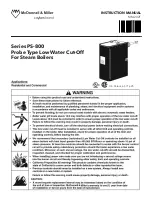
15
2.4
SIDEWALL VENTING
When fitted with the factory supplied vent terminal, the
Advantus
can vent up to 100 equivalent feet. Elbows can range from 7 to 19 feet
in equivalent length depending on centerline radius. Refer to table 3 for vent sizes.
Appliances may be installed with either a horizontal sidewall vent or vertical roof top vent. Terminals differ with each application. Use
approved single wall or double wall vent.
Periodically check to ensure that the vent terminal is unobstructed.
This venting sy
stem uses the appliance’s internal combustion air fan to force the flue products out horizontally.
The
Advantus
fan generates a positive pressure in the flue. Combustion air is drawn from the equipment room. Sidewall terminations
are available from the factory. Refer to local codes for proper installation and location of vent terminals.
2.4.1
SIDEWALL VENT TERMINAL & SIDEWALL INTAKE AIR TERMINAL
The opening through the wall for installation of the sidewall vent terminal must provide an air space clearance of 1 inch (2.5 cm)
to combustible material around the flue pipe. The diameter of the opening for the air inlet will be the same as the nominal size
of the pipe.
Install the proper vent pipe to the vent terminal provided by
Camus Hydronics
.
Follow all requirements in the General Venting sections for venting flue products to the outdoors.
2.4.2
LOCATION OF A SIDEWALL VENT TERMINATION
The vent terminal shall terminate at least 3 feet (1 m) above any forced air inlet within 10 feet (3 m) horizontally.
The vent terminal MUST NOT terminate below a forced air intake at any distance.
Do not terminate the vent in a window well, stairwell, alcove, courtyard or other recessed area. The vent cannot terminate below
grade.
The vent shall not terminate near soffit vents or crawl space vents or other areas where condensate or vapor could create a
nuisance or hazard or cause property damage.
Do not terminate the vent where condensate or vapor could cause damage or could be detrimental to the operation of regulators,
relief valves or other equipment.
The vent shall not terminate over public walkways.
The vent system shall terminate at least 3 feet (1 m) above normal snow levels and least 7 feet (2.15 m) above grade when
located adjacent to public walkways.
The vent terminal shall not be installed closer than 3 feet (1 m) from an inside corner of an L-shaped structure.
The vent terminal should have a minimum clearance of 4 feet (1.25 m) horizontally from and in no case above or below, unless
a 4 foot (1.25 m) horizontal distance is maintained from electric meters, gas meters, regulators and relief equipment. In all
cases, local codes take precedence.
Flue gas condensate can freeze on exterior walls or on the vent terminal. Frozen condensate on the vent cap can result in a
blocked flue condition. Some discoloration to exterior building surfaces can be expected. Adjacent brick or masonry surfaces
should be protected with a rust-resistant sheet metal plate.
The vent shall not terminate where condensate vapor could cause damage or could be detrimental to the operation of regulators,
relief valves, or other equipment
Содержание ADVANTUS AVH 500
Страница 2: ......
Страница 3: ......
Страница 38: ...31 Figure 23 Recommended Piping with Reverse Return and Variable Primary Flow...
Страница 70: ...63 Figure 44 Typical Gas Train Models AV1000 3000 Figure 45 Typical Gas Train Models AV3500 4000...
Страница 88: ...81 PART 12 EXPLODED VIEW Figure A...
Страница 89: ...82 Figure B FAN BURNER ASSEMBLY AV500 600 some items may not be as shown...
Страница 90: ...83 Figure C FAN BURNER ASSEMBLY AV800 4000 some items may not be as shown...
Страница 91: ...84 Figure D Figure E...
Страница 92: ...85 Figure F Figure G...
Страница 93: ...86 Figure H CONTROL BOARD ASSEMBLY...
Страница 100: ...93 PART 13 ELECTRICAL DIAGRAMS...
Страница 101: ...94...
Страница 102: ...95...
















































